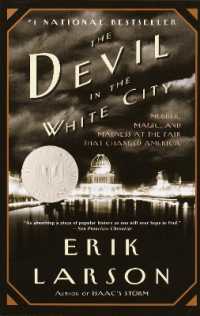Full Description
Scoring Italian Cinema: Patterns of Collaboration redefines what it means to write music for the cinema. In eight richly illustrated chapters and a deft introduction, nine leading music and film scholars revisit the great theme of artistic collaboration from a heretofore unexplored angle: the relationship between film directors and composers in the "Long Italian Post-War" (ca. 1945-1975).
Spurred by the surfacing of printed and manuscript scores, sketches, drafts, tapes, letters and miscellaneous notes, the authors of Scoring Italian Cinema examine afresh the partnerships between such figures as Federico Fellini and Nino Rota, Michelangelo Antonioni and Giovanni Fusco, Elio Petri and Ennio Morricone, and Dario Argento and Goblin. The volume also brings to light the role of conductors and performers as well as producers and screenwriters in creating the soundtracks of some of the most important films in the history of Italian cinema, including Bitter Rice (Riso Amaro, 1949), La strada (1954) and Salvatore Giuliano (1962). The intrinsically polyvocal nature of the process of completing a score, such as it emerges in the case studies gathered in Scoring Italian Cinema, invites us to rethink of composing for the films as a new kind of expanded, distributed musical practice.
Meticulously researched and written in an accessible style, Scoring Italian Cinema will appeal to scholars and practitioners in the fields of music, film and media studies.
Contents
List of Contributors
Acknowledgements
Introduction (Giorgio Biancorosso and Roberto Calabretto)
Chapter 1 The Conductor as Collaborator in Early Italian Sound Film
(Marco Ladd)
Chapter 2 Petrassi and LUX Film
(Roberto Calabretto)
Chapter 3 Gershwin's 'The Man I Love' Reloaded: Antonioni-Fusco's Soundtrack for Cronaca di un Amore (1950)
(Dominique Nasta)
Chapter 4 The Déjà Oublié-Effect: Rota, 'Gelsomina', and Fellini's La strada
(Giorgio Biancorosso)
Chapter 5 'The Equation of Liberty': Self-Sufficiency and Expressive Freedom in De Seta's Documentaries of the 1950s
(Ilario Meandri and Giulia Ferdeghini)
Chapter 6 'Not a Symphony of Its Own': Creative Patterns in the Collaboration between Francesco Rosi and Piero Piccioni
(Maurizio Corbella)
Chapter 7 Collaboration and/as Bricolage: Petri, Pirro, Volonté and Morricone between Standard Practice and Authentication in the Aftermath of 1968
(Alessandro Cecchi)
Chapter 8 The Sound of Madness and Horror: Music and Multiple Authorship in Profondo Rosso (1975)
(Emilio Audissino)
Index








